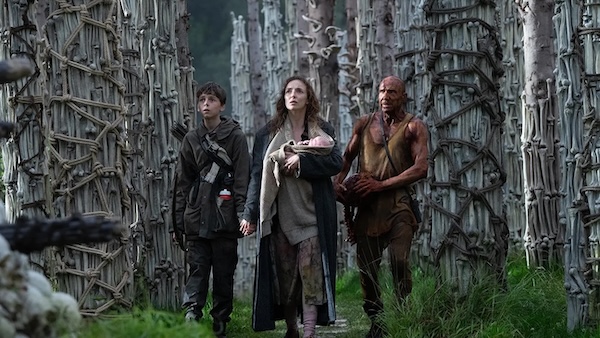Film Review: “28 Years Later” — World War ZZZZ…
By Peter Keough
28 Years Later is too little, too late.
28 Years Later. Directed by Danny Boyle. At the Boston Common, Alamo Drafthouse, Coolidge Corner Theatre, Causeway, and Kendall Square.

From left: Alfie Williams, Jodie Comer, and Ralph Fiennes in 28 Years Later. Photo: Courtesy of SONY Pictures
If ever there was a time for a brutal, dark, and satiric dystopian horror flick about a “rage virus,” it is now. Sadly, director Danny Boyle and screenwriter Alex Garland’s tepid, tedious, and weird third entry in this moribund franchise is not that movie. To be fair, even the first film, the fitfully exciting but morbidly derivative 28 Days Later (2003), does little to relate the pathological cause of a furious, filthy zombie infestation to any deeper social, political, or psychological truths.
The second in the series, 28 Weeks Later (2007), the work of Spanish director Juan Carlos Fresnadillo, proved more trenchant and relevant. But this belated third entry, the first in a projected trilogy, is just an inept pastiche, a dreary, unintentionally silly musing. It is devoid of point or significance, with Boyle’s incessant stylistic doodlings (hey, they worked in Trainspotting and, according to the studio press release, this is an “‘auteur horror’ story”) only underscoring its inconsequentiality.
It begins 28 years earlier with a group of frightened kids in a living room watching Teletubbies on TV. Then the zombies burst in and blood squirts on the screen. That’s about as subtle as the movie gets. One boy escapes, flees to a church where his father, the pastor, ecstatically awaits the deliverance of the zombie horde. Nonetheless, he tells his son to head for the hills, presenting him with a crucifix to protect him. Will we see this person with his telltale cross again? Unfortunately, yes.
Flash forward to the title time and a Road Warrior-like community that has been established as a bastion against the plague on a small island off the Scottish coast. It seems to be an idyllic, retro society that survives with primitive tools and weapons like bows and arrows and the occasional buck-knife. Not just technology, but all popular culture prior to the 1950s has been lost — no internet, influencers, or MAGA. Sign me up! But they have institutionalized an initiation rite in which a dad takes his son to the mainland, crossing the narrow strait at low tide. There they must check out the status of the “infected,” bag a couple of zombies, and head back before they get turned into zombies themselves.
It’s time for 12-year-old Spike (Alfie Williams, a fine young actor who stoically endures the filmmakers’ shenanigans) to join his tough macho dad Jamie (Aaron Taylor-Johnson) on the trip. His mom Isla (Jodie Comer) objects to the excursion, but she’s bed-bound and mentally off because of an unknown affliction, so dad placates her with lies as Spike looks on ruefully.
As they march out to the causeway, Boyle indulges in some cinematic razzmatazz, including a 1915 recording of the Rudyard Kipling poem “Boots” illustrated by quick cuts to old archival news footage, snippets from Laurence Olivier’s Henry V, and unsourced infrared shots of zombies doing horrible things. Later, he supplements these intrusions with other gratuitous devices, like arbitrary drone shots, odd camera angles, or CGI images of a huge deer stampede. Is it a harbinger of some shocking revelation yet to come, or a gaudy distraction from the absurdity of the narrative?
Meanwhile, on the mainland, father and son barely escape alive. Spike has his inglorious first kill, but he seems unenthusiastic about his father’s bloodlust. Also, he bristles at his dad’s tall tales about his son’s heroism that he spews at their welcome home party. Mostly, though, he’s troubled by a fire he saw on the mainland. Jamie claims ignorance about the conflagration, but an island old-timer tells Spike that it is probably the work of crazy Dr. Kelson, who disappeared years ago on the mainland and is rumored to be up to all kinds of unholy stuff. Spike perks up, learning of the existence of a doctor who might be able to help cure his mother’s mysterious ailment. So he sneaks off, invalid mother in tow, and heads back to the realm of the dead.
Perhaps the filmmakers are touching on classical myths here, but it turns out to be a pretty bad idea. Mother and son encounter a whole theme park assortment of close calls, including one with a specimen of the giant zombies called “alphas” whose hobby is ripping off heads and carrying them around, complete with dangling spinal columns, like trophies. Some scenes are as ludicrous as the antics in Shaun of the Dead (2004), but not as funny.
They also inevitably track down the red-dyed, bald, blowgun-wielding Dr. Kelson, played by Ralph Fiennes as a cross between Col. Kurtz in Apocalypse Now and Yoda, and given to such apothegms as “Memento mori – it means ‘remember you shall die!’” and “Ah, the miracle of the placenta!” He has constructed a giant boneyard that is like an outdoor catacomb as designed by Anselm Kiefer. There he performs a fetishistic rite that combines the worship of motherhood and death with Hallmark card sentimentality to jaw-dropping effect.
What does the future hold? 28 Years Later: The Bone Temple, the second in a planned trilogy of sequels, is written by Garland, so it promises more of his meretricious spectacle at the expense of genuine tragedy. But the director is Nia DaCosta, whose Little Woods (2017) demonstrated a keen sensitivity to genuine human issues. And who knows what new forms the rage virus will take by then in the real world?
Peter Keough writes about film and other topics and has contributed to numerous publications. He was the film editor of the Boston Phoenix from 1989 to its demise in 2013 and has edited three books on film, most recently For Kids of All Ages: The National Society of Film Critics on Children’s Movies (Rowman & Littlefield, 2019).
Tagged: "28 Days Later", Alex Garland, Alfie Williams, Danny Boyle, Jodie Comer

Miracle of the placenta! A boy kisses his mother’s skull goodbye atop the ‘Kiefer’ skull centerpiece (apt description ). A zombie gives birth. A Shell gas station with the S missing next to a restaurant that advertises “Eat Here”. A zombie pin-cushioned with arrows like a martyred saint. An infant like a wee Christ child in some medieval looking future world. Among the 5 people in the bargain matinee escaping the 100 heat – why was I the only one laughing?
was the comedy intentional? I still don’t know.